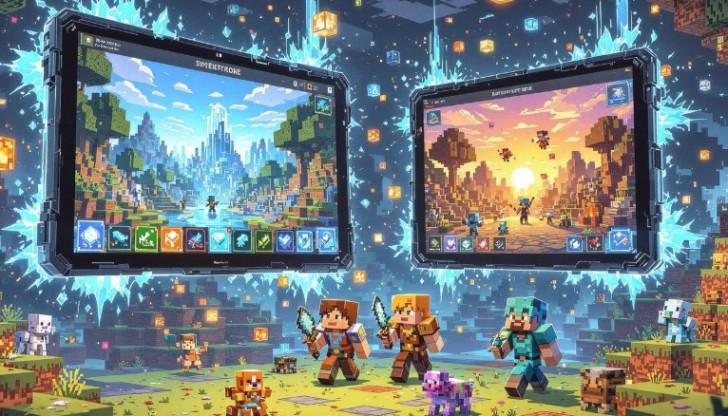Want to mod Minecraft Bedrock? Good news—it’s much simpler than you might expect. Unlike Java Edition, where modifications involve working with complex code through third-party frameworks, Bedrock uses Microsoft’s official Add-ons, which are designed to work safely across Windows 10, Xbox, PlayStation, Nintendo Switch, and mobile devices. You can apply them without worrying about breaking your game.
With Bedrock Add-ons, you can:
- Change textures to make your world visually stunning.
- Add new mobs and game mechanics with behavior packs.
- Enhance audio and visuals through resource packs.
Even the best Minecraft Bedrock seeds become more exciting when paired with the right mods. From realistic water physics to dragons roaming your world, Add-ons let you fully customize your experience after the latest Bedrock updates.
If you’re exploring server setups for your Add-on packs, the Minecraft community on Reddit often discusses the top modded minecraft hosting sites, sharing real performance insights and recommendations. Checking these discussions helps you choose a reliable host that supports Bedrock mods smoothly and keeps your multiplayer experience lag-free.
Bedrock Add-ons vs Java Mods
Modding works differently in Bedrock and Java editions. Bedrock relies on official Add-ons created by Microsoft, ensuring compatibility across all devices. Java, however, requires modifying the game code through community-made frameworks like Forge or Fabric.
Key differences:
- Loading: Bedrock Add-ons are placed in specific folders and activated via the in-game interface. Java mods require loaders to inject code directly into the game.
- Scope: Bedrock mods mainly tweak textures, behaviors, and existing mobs. Java mods can add new dimensions, complex machinery, and total game overhauls.
- Installation: Bedrock uses in-game menus, while Java often needs external launchers.
- Compatibility: Bedrock works everywhere, while Java is limited to PC.
The Minecraft Marketplace offers convenient Add-ons but often charges for content that can be found for free elsewhere. Community platforms like Modrinth provide thousands of free Add-ons with virus scanning and version checks, while CurseForge has a smaller Bedrock selection but also works reliably.If you’re planning to host your own modded server—whether for Bedrock or Java—consider using a reliable provider like Godlike. Their optimized Minecraft hosting ensures smooth gameplay, stable performance, and full support for both Add-ons and Java mods, making it easy to create and manage your customized world.
Where to Find Safe Bedrock Mods
Start with official sources to stay safe. The built-in Marketplace vettes Add-ons before release, preventing accidental downloads of harmful content. Community platforms like Modrinth and CurseForge offer free alternatives with safety checks. Planet Minecraft hosts user-created mods, but always check comments to confirm quality.
Red flags to watch for:
- Sites asking for surveys, personal info, or executables.
- Legitimate Bedrock Add-ons come as .mcpack or .mcaddon files.
- Simple texture packs should be under 50MB unless ultra-HD. Behavior packs rarely exceed 10MB.
Installing Your First Bedrock Mod
Before you start, backup your world. Go to Settings → Storage, find your world, and hit Copy. Trust me—this saves headaches if something goes wrong.
Installation steps:
- Download .mcpack or .mcaddon from a trusted source.
- Double-click (Windows) or tap (mobile) to auto-import.
- Open Minecraft, create a new world or edit an existing one.
- Activate the Add-on under Resource Packs and Behavior Packs.
- Apply changes and load your world.
Troubleshooting:
- Black screen = incompatible version.
- Crash on load = remove the last pack added.
- Missing textures = redownload from the original source.
Always test new Add-ons in a creative world first to avoid conflicts between behavior packs.
Best Starter Mods for Beginners
For newcomers, start small:
- Faithful 32x: Sharpens textures while keeping the original Minecraft style.
- Simple Shaders (Modrinth): Adds realistic water reflections and dynamic shadows without hurting performance.
- Armor Stand Editor: Pose armor for impressive displays.
- More TNT Types: Introduces new mining and explosive variants.
- Zombie Apocalypse: Adds challenging night mobs.
- Better Villages: Expands structures and trading options.
- Quick Harvest: Collect crops with a single click to save farming time.
These mods generally don’t conflict since they modify different mechanics. The official Marketplace charges for some content, but CurseForge provides free alternatives. Watching video previews can help decide which Add-ons to use.
Managing Multiple Mods
Running multiple Add-ons requires understanding Bedrock’s loading system:
- Resource packs stack from bottom to top; top layers override conflicts.
- Behavior packs merge changes unless they modify the same properties.
Test one pack at a time. If crashes occur when combined, conflicts exist. Minecraft logs (LocalState/games/com.mojang/minecraftpe/dev_log.txt) show which files clash. Experienced modders experiment in creative worlds first to avoid corrupting survival worlds.
Use grouped collections for themed gameplay (e.g., medieval, futuristic). Modrinth manages dependencies automatically. If performance drops, remove heavy texture packs first—they consume the most resources.
Wrapping Up
You’ve now transformed your Minecraft Bedrock world with texture packs and behavior modifications. Start with basic textures like Faithful 32x, add shaders for atmosphere, then explore behavior packs when comfortable.
Each Bedrock update opens new possibilities. With careful experimentation and safe Add-on practices, you can create a world that’s uniquely yours. Grab your first mod and start exploring!
 Editorial staff
Editorial staff

 Editorial staff
Editorial staff


